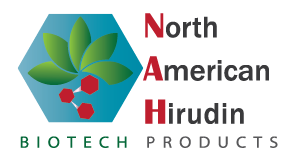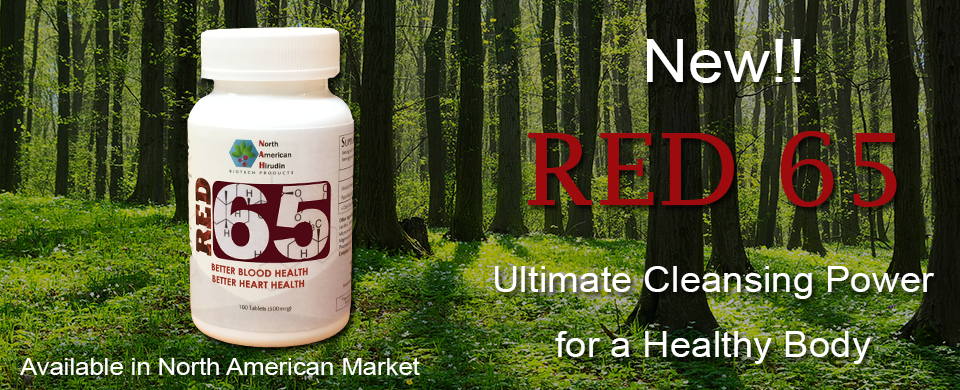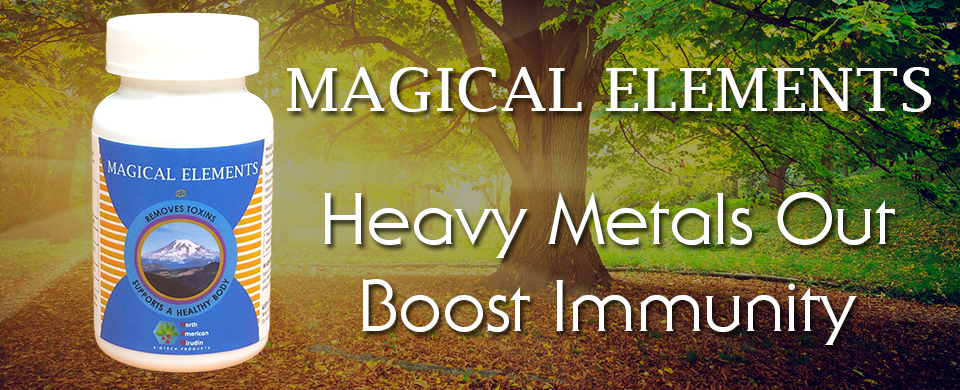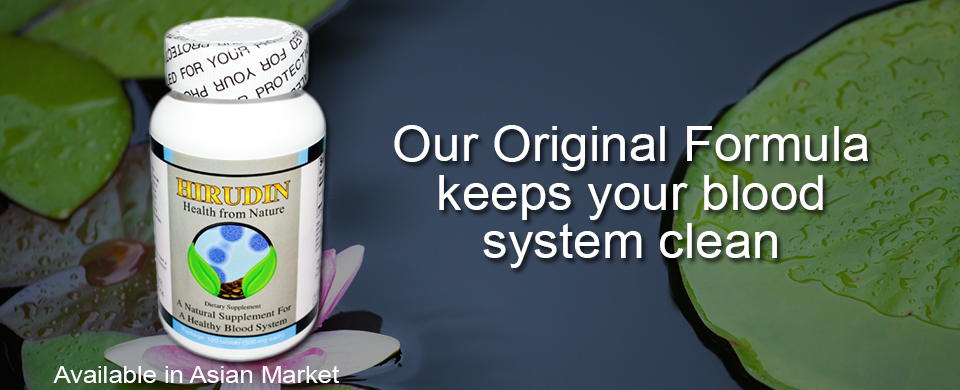The evolution of Hirudin in Medical Science
A Natural Blood Cleanser For Optimal Health
and Anti-Aging.
While the word HIRUDIN is not often heard in everyday language the medical value of HIRUDIN has long been recognized by the medical profession. Hirudin has long been used in the practice of Chinese medicine dating back to several thousand years . .
Leeching was also practiced as an art in ancient Egypt. It reached its
zenith in the late 18th and early 19th centuries. The antithrombotic quality of leech saliva was first noted by Haycraft in 1884 and the active anticoagulant ingredient isolated in 1904 by Jacoby. He gave this agent the name ‘hirudin’. Hirudin was isolated in pure crystalline form by Markwardt in 1957 and first produced in quantity by genetic engineering in 1986. The salivary glands of several species of leech also contain other biologically active substances which are currently undergoing investigation.
The following article is from Lab Lines, March/April 2001 Volume 11 A publication of the Department of Pathology and Laboratory Medicine at the University of Cincinnati
Hirudin and Its Derivatives as Thrombin Inhibitors
Thrombosis is a major cause of death and disability from myocardial infarction, stroke, peripheral ischemia, and pulmonary embolism. Standard heparin has been used successfully for the prevention and treatment of thrombotic disorders. However, its use has several limitations, including a variable anticoagulant effect, an inability to inhibit clot-bound thrombin, and the potential to cause thrombocytopenia. Direct thrombin inhibitors such as hirudin do not share these limitations.
Hirudin is the most potent non-covalent inhibitor of thrombin. It is a single peptide chain of 65 amino acids with molecular weight of ~7000. It is isolated from the salivary gland of the medicinal leech, Hirudo medicinalis. It selectively binds thrombin in a 1:1 fashion at each of two sites on the enzyme: 1) the domain that recognizes fibrinogen, and 2) the catalytic domain. Because of the specificity of binding, hirudin does not inhibit other enzymes in the coagulation or fibrinolytic pathways, such as factor Xa, factor IXa, kallikrein, activated protein C, plasmin or tissue-type plasminogen activator.
Hirudin produces a dose-dependent increase in the activated partial thromboplastin time (aPTT), prothrombin time and thrombin time. Unlike heparin, after which wide fluctuations in the aPTT are common, hirudin maintains a stable aPTT during its infusion period. The ability to achieve a more stable aPTT may be an important benefit because it avoids periods of inadequate anticoagulation. In addition to a dose-dependent increase in the aPTT, hirudin achieves a very consistent level of anticoagulation. In contrast to heparin, hirudin: 1) does not require antithrombin as a cofactor, 2) is not inactivated by anti-heparin protein, 3) has no direct effect on platelets, and 4) may also inactivate thrombin bound to clots or to subendothelium. Hirudin also appears to improve indices of coronary reperfusion and patency. Initial results with clinical end points, including death or myocardial infarction, appear to favor hirudin over heparin.
The hirudin-thrombin complex circulates in the blood for 4 to 6 hours after which it is cleared by the reticuloendothelial system. Circulating free hirudin is excreted by the kidneys and, thus, dose adjustment must be made in the setting of renal dysfunction. The dose-dependent elimination half-life is 1-2 hours. Because it is a foreign polypeptide, hirudin may elicit an immunological response.
Today, hirudin and synthetic analogues of hirudin are being developed using recombinant DNA technology. These drugs are alternatives to heparin for the treatment of: 1) unstable angina, 2) abrupt closure and restenosis following coronary angioplasty, and 3) prevention of deep vein thrombosis after major orthopedic surgery. They are also used as adjunct to fibrinolytic therapy. They are fast becoming the drugs of choice for the anticoagulant treatment of patients with heparin-induced thrombocytopenia with thromboembolic complications.
The aPTT has been used to monitor hirudin treatment. Chromogenic assays for accurate determination of plasma levels of hirudin are commercially available in Europe. However, in a recently published multicenter study on hirudin treatment of HIT patients, hirudin plasma levels did not correlate with bleeding complications. The ecarin-clotting time is also used in Europe to monitor hirudin levels. In the United States, no FDA-approved methods are yet available to monitor hirudin.
The primary adverse effect of hirudin is bleeding. The majority of bleeding events occur at invasive sites. An antidote is not yet available.
Lab Lines Authors: Irena Sheyn, MD, Cytopathology Fellow, and Gregory S. Retzinger, MD, PhD, Deparment of Pathology and Laboratory Medicine, Universtiy of Cincinnati. References: Cannon CP et al. Hirudin: initial results in acute myoc Cardial infarction, unstable angina and angioplasty. JACC, 1995; 25: 30S-37S Fischer KG et al. Recombinant hirudin (lepirudin) as Anticoagulant in Intensive care patients treated with continuous hemodialysis. Kidney Internat, 1999; 56: S46- S50 5. Greinacher A et al. Lepirudin (recombinant hirudin) for parenteral anticoagulation in patients with heparin-in duced thrombocytopenia. Circulation 1999, 100: 587-593 6. Johnson PH. Hirudin: clinical potential of a thrombin in hibitor. Annu Rev. Med 1994; 45: 165-177 7: Steuer S et al. Anticoagulation with r-hirudin in a patient with acute renal failure and heparin-induced thrombocy topenia. Nephrol Dial Transplant 1999; 14: 45-47









